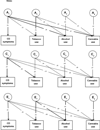Role of overlapping genetic and environmental factors in the relationship between early adolescent conduct problems and substance use in young adulthood
- PMID: 26748618
- PMCID: PMC4861688
- DOI: 10.1111/add.13303
Role of overlapping genetic and environmental factors in the relationship between early adolescent conduct problems and substance use in young adulthood
Abstract
Aims: To determine (1) the prospective associations of conduct problems during early adolescence with tobacco, alcohol and cannabis use in young adulthood and (2) to what extent these associations are due to overlapping genetic versus environmental influences.
Design: A prospective twin study using biometric twin modelling.
Setting: Finland.
Participants: A total of 1847 Finnish twins (943 males and 904 females) were interviewed in early adolescence, 73% of whom (n = 1353, 640 males and 713 females) were retained in young adulthood.
Measurements: Symptom counts of conduct disorder (CD) criteria were obtained from a semi-structured clinical interview in early adolescence [age 14-15 years, mean = 14.2, standard deviation (SD) = 0.15]. Frequency of alcohol, tobacco and cannabis use was obtained from a semi-structured clinical interview in young adulthood (age 19.9-26.6 years, mean = 22.4, SD = 0.7).
Findings: We found modest to moderate phenotypical correlations (r = 0.16-0.35) between early adolescent CD symptoms and substance use in young adulthood. In males, the phenotypical correlations of CD symptoms with all three substance use variables are explained largely by overlapping genetic influences. In females, overlapping shared environmental influences predominantly explain the phenotypical correlation between CD symptoms and tobacco and cannabis use.
Conclusions: Conduct disorder symptoms in early adolescence appear to moderately predict substance use in early adulthood. In males, genetic influences seem to be most important in explaining the relationship between conduct disorder symptoms and substance use whereas in females, shared environmental influences seem to be most important.
Keywords: Adolescent twins; common environments; conduct problems; genetics; substance use; young adult twins.
© 2016 Society for the Study of Addiction.
Conflict of interest statement
The authors have no conflicts of interest.
Figures


Comment in
-
Commentary on Verweij et al. (2016): Conduct problems and substance use-genetic and environmental perspectives on sex differences.Addiction. 2016 Jun;111(6):1046-7. doi: 10.1111/add.13371. Addiction. 2016. PMID: 27157903 Free PMC article.
Similar articles
-
Genetic and Environmental Influences on Smoking Behavior across Adolescence and Young Adulthood in the Virginia Twin Study of Adolescent Behavioral Development and the Transitions to Substance Abuse Follow-Up.Twin Res Hum Genet. 2015 Feb;18(1):43-51. doi: 10.1017/thg.2014.78. Twin Res Hum Genet. 2015. PMID: 25662421 Free PMC article.
-
Sex differences in genetic and environmental contributions to alcohol consumption from early adolescence to young adulthood.Addiction. 2016 Jul;111(7):1188-95. doi: 10.1111/add.13321. Epub 2016 Feb 27. Addiction. 2016. PMID: 26802679
-
The role of conduct disorder in the relationship between alcohol, nicotine and cannabis use disorders.Psychol Med. 2015 Dec;45(16):3505-15. doi: 10.1017/S0033291715001518. Epub 2015 Aug 18. Psychol Med. 2015. PMID: 26281760 Free PMC article.
-
Cannabis controversies: how genetics can inform the study of comorbidity.Addiction. 2014 Mar;109(3):360-70. doi: 10.1111/add.12436. Epub 2014 Jan 19. Addiction. 2014. PMID: 24438181 Free PMC article. Review.
-
FinnTwin12 Cohort: An Updated Review.Twin Res Hum Genet. 2019 Oct;22(5):302-311. doi: 10.1017/thg.2019.83. Epub 2019 Oct 23. Twin Res Hum Genet. 2019. PMID: 31640839 Free PMC article. Review.
Cited by
-
CB1-Dependent Long-Term Depression in Ventral Tegmental Area GABA Neurons: A Novel Target for Marijuana.J Neurosci. 2017 Nov 8;37(45):10943-10954. doi: 10.1523/JNEUROSCI.0190-17.2017. Epub 2017 Oct 16. J Neurosci. 2017. PMID: 29038246 Free PMC article.
-
Predicting Alcohol Dependence Symptoms by Young Adulthood: A Co-Twin Comparisons Study.Twin Res Hum Genet. 2021 Aug;24(4):204-216. doi: 10.1017/thg.2021.36. Epub 2021 Sep 16. Twin Res Hum Genet. 2021. PMID: 34526173 Free PMC article.
-
Post-GWAS in Psychiatric Genetics: A Developmental Perspective on the "Other" Next Steps.Genes Brain Behav. 2018 Mar;17(3):e12447. doi: 10.1111/gbb.12447. Epub 2018 Feb 5. Genes Brain Behav. 2018. PMID: 29227573 Free PMC article. Review.
-
Commentary on Verweij et al. (2016): Conduct problems and substance use-genetic and environmental perspectives on sex differences.Addiction. 2016 Jun;111(6):1046-7. doi: 10.1111/add.13371. Addiction. 2016. PMID: 27157903 Free PMC article.
-
Exploring how Family and Neighborhood Stressors Influence Genetic Risk for Adolescent Conduct Problems and Alcohol Use.J Youth Adolesc. 2020 Jul;49(7):1365-1378. doi: 10.1007/s10964-019-01098-9. Epub 2019 Aug 12. J Youth Adolesc. 2020. PMID: 31407187 Free PMC article.
References
-
- Brook JS, Brook DW, Zhang C, Cohen P. Tobacco Use and Health in Young Adulthood. The Journal of Genetic Psychology: Research and Theory on Human Development. 2004;165:310–323. - PubMed
Publication types
MeSH terms
Grants and funding
LinkOut - more resources
Full Text Sources
Other Literature Sources
Medical

